Abstract
There is now evidence that several classes of nitro compounds which have been used as radiosensitizers also function as cytotoxic agents specific for hypoxic cells. The 2-nitroimidazole, Ro-07-0582, (1-(2-nitroimidazol-1-yl)-3-methoxy-2-propanol) is a compound of this type, and its effectiveness as a cytotoxic agent is dependent on drug concentration, contact time and temperature. In vitro, Ro-07-0582 in air at 37 degrees C does not cause loss of cell viability at concentrations up to 2 mM, even when in contact for several days. In contrast, hypoxic cells do not tolerate much lower concentrations of drugs, even if the contact time is only a few hours. When the temperature is raised above 37 degrees C, there is a pronounced increase in the slope of the survival curves; for example, at 41 degrees C (for 1 mM Ro-07-0582, (200 microng/ml), the slope changes by a factor of 2-0 relative to that for 37 degrees C. For cells in air at 41 degrees C, as at 37 degrees C, there is no toxic effect at the concentration of drug tested. In the absence of drug, there is no cytotoxic effect of hyperthermia alone under these conditions. These results are discussed in terms of Arrhenius parameters.
Full text
PDF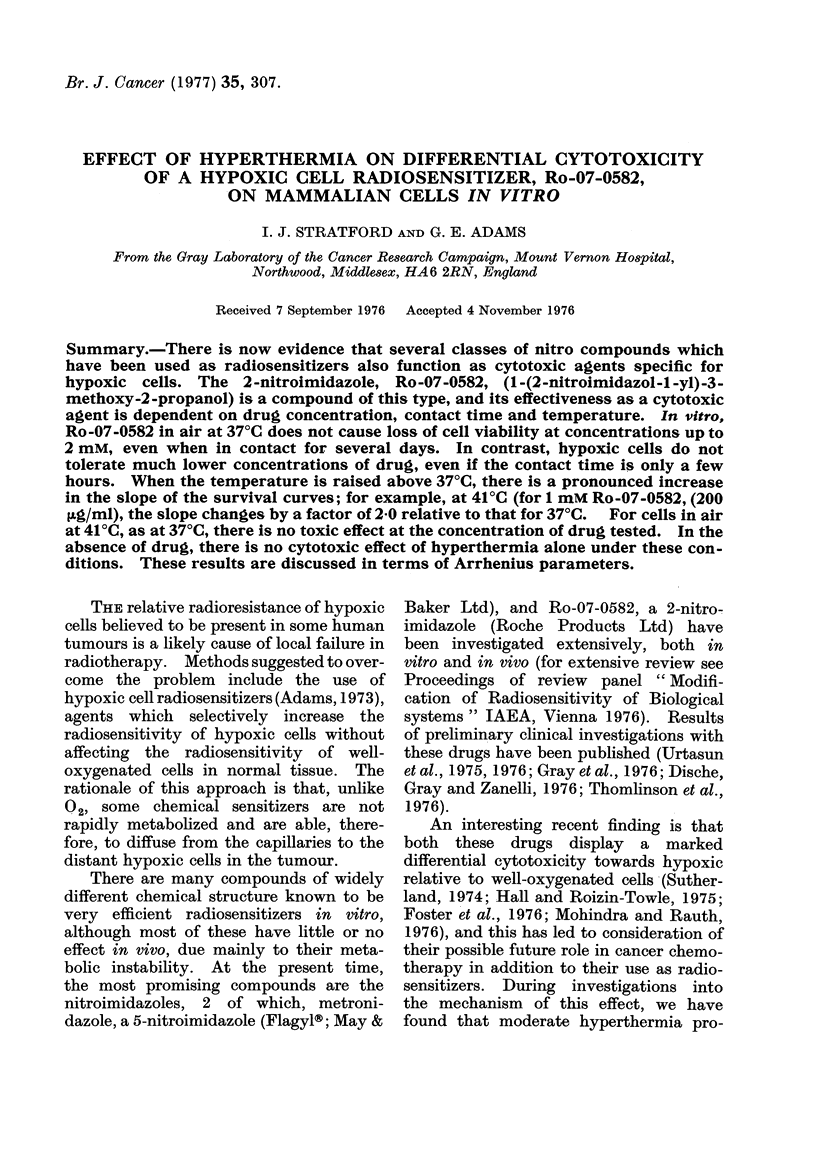

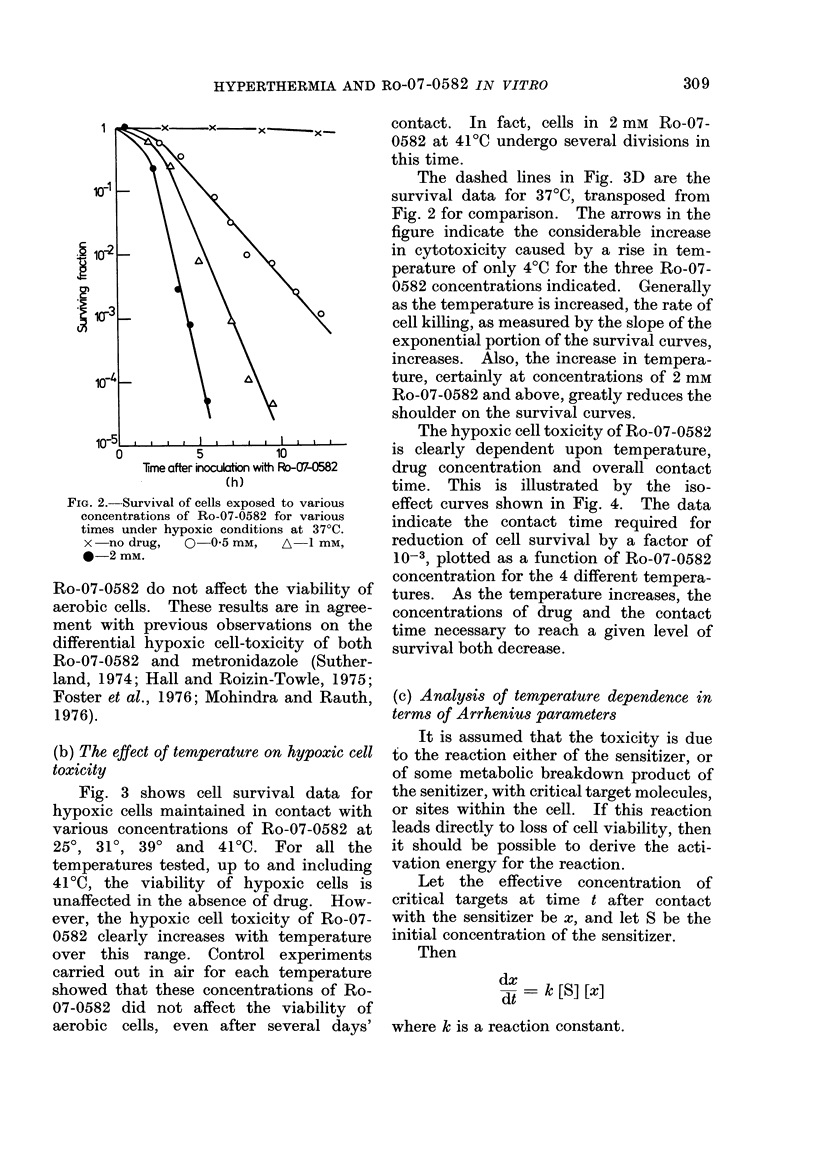
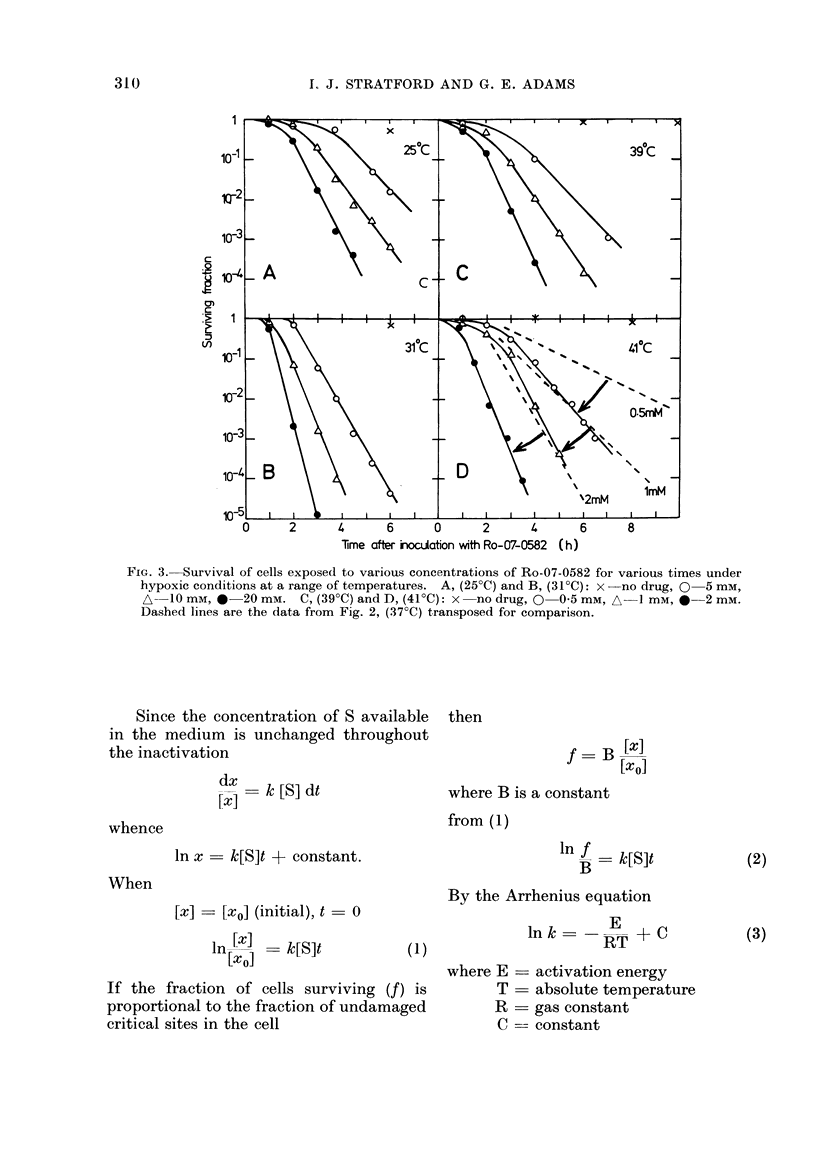

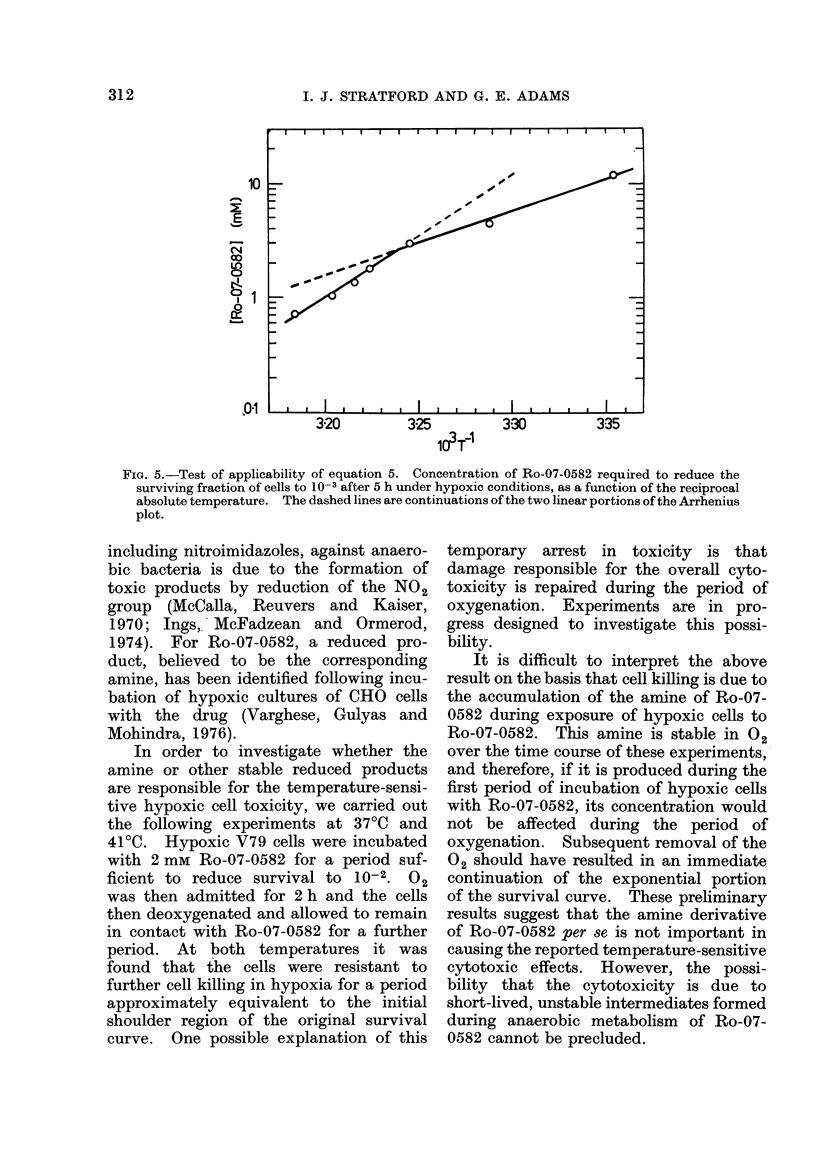
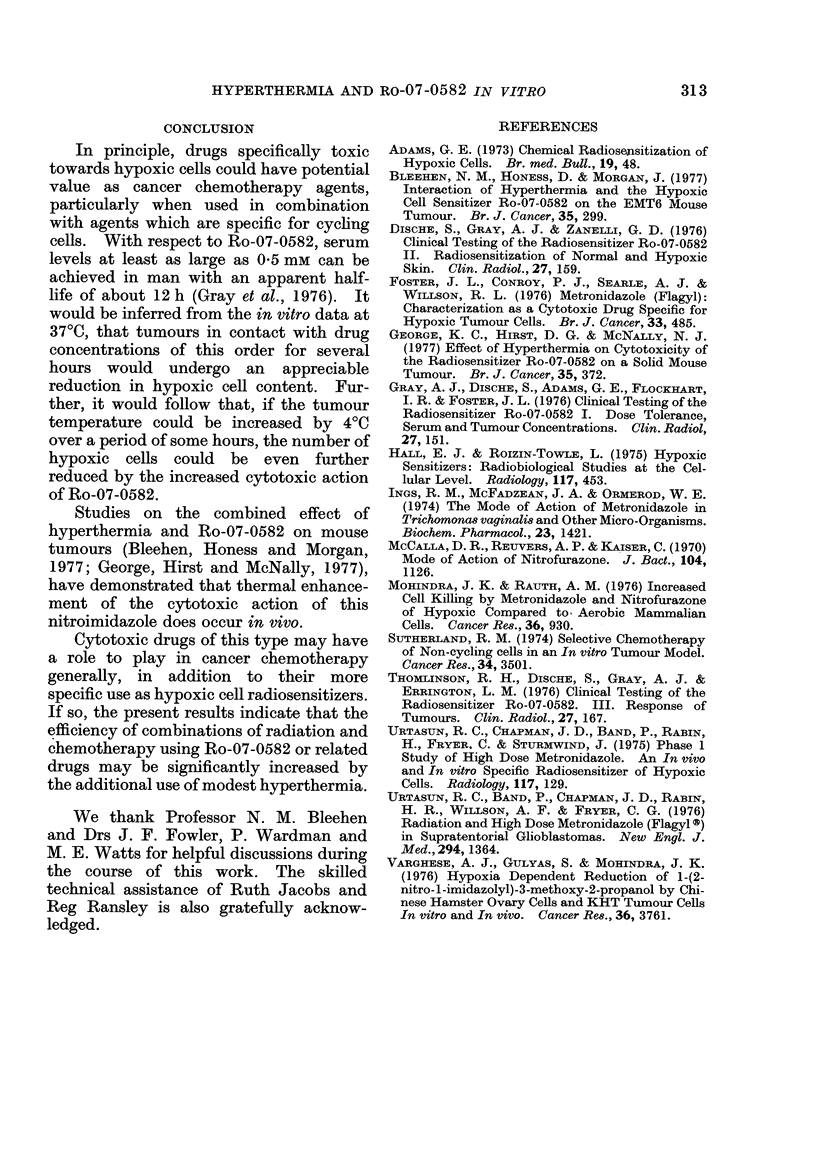
Selected References
These references are in PubMed. This may not be the complete list of references from this article.
- Adams G. E. Chemical radiosensitization of hypoxic cells. Br Med Bull. 1973 Jan;29(1):48–53. doi: 10.1093/oxfordjournals.bmb.a070956. [DOI] [PubMed] [Google Scholar]
- Bleehen N. M., Honess D. J., Morgan J. E. Interaction of hyperthermia and the hypoxic cell sensitizer Ro-07-0582 on the EMT6 mouse tumour. Br J Cancer. 1977 Mar;35(3):299–306. doi: 10.1038/bjc.1977.43. [DOI] [PMC free article] [PubMed] [Google Scholar]
- Dische S., Gray A. J., Zanelli G. D. Clinical testing of the radiosensitiser Ro-07-0582. II. Radiosensitisation of normal and hypoxic skin. Clin Radiol. 1976 Apr;27(2):159–166. doi: 10.1016/s0009-9260(76)80138-9. [DOI] [PubMed] [Google Scholar]
- Foster J. L., Conroy P. J., Searle A. J., Willson R. L. Metronidazole (Flagyl): characterization as a cytotoxic drug specific for hypoxic tumour cells. Br J Cancer. 1976 May;33(5):485–490. doi: 10.1038/bjc.1976.78. [DOI] [PMC free article] [PubMed] [Google Scholar]
- George K. C., Hirst D. G., McNally N. J. Effect of hyperthermia on cytotoxicity of the radiosensitizer Ro-07-0582 in a solid mouse tumour. Br J Cancer. 1977 Mar;35(3):372–375. doi: 10.1038/bjc.1977.52. [DOI] [PMC free article] [PubMed] [Google Scholar]
- Gray A. J., Dische S., Adams G. E., Flockhart I. R., Foster J. L. Clinical testing of the radiosensitiser Ro-07-0582. I. Dose tolerance, serum and tumour concentrations. Clin Radiol. 1976 Apr;27(2):151–157. doi: 10.1016/s0009-9260(76)80137-7. [DOI] [PubMed] [Google Scholar]
- Hall E. J., Roizin-Towle L. Hypoxic sensitizers: radiobiological studies at the cellular level. Radiology. 1975 Nov;117(2):453–457. doi: 10.1148/117.2.453. [DOI] [PubMed] [Google Scholar]
- Ings R. M., McFadzean J. A., Ormerod W. E. The mode of action of metronidazole in Trichomonas vaginalis and other micro-organisms. Biochem Pharmacol. 1974 May 1;23(9):1421–1429. doi: 10.1016/0006-2952(74)90362-1. [DOI] [PubMed] [Google Scholar]
- McCalla D. R., Reuvers A., Kaiser C. Mode of action of nitrofurazone. J Bacteriol. 1970 Dec;104(3):1126–1134. doi: 10.1128/jb.104.3.1126-1134.1970. [DOI] [PMC free article] [PubMed] [Google Scholar]
- Mohindra J. K., Rauth A. M. Increased cell killing by metronidazole and nitrofurazone of hypoxic compared to aerobic mammalian cells. Cancer Res. 1976 Mar;36(3):930–936. [PubMed] [Google Scholar]
- Sutherland R. M. Selective chemotherapy of noncycling cells in an in vitro tumor model. Cancer Res. 1974 Dec;34(12):3501–3503. [PubMed] [Google Scholar]
- Thomlinson R. H., Dische S., Gray A. J., Errington L. M. Clinical testing of the radiosensitiser Ro-07-0582. III. Response of tumours. Clin Radiol. 1976 Apr;27(2):167–174. doi: 10.1016/s0009-9260(76)80139-0. [DOI] [PubMed] [Google Scholar]
- Urtasun R. C., Chapman J. D., Band P., Rabin H. R., Fryer C. G., Sturmwind J. Phase 1 study of high-dose metronidazole: a specific in vivo and in vitro radiosensitizer of hypoxic cells. Radiology. 1975 Oct;117(1):129–133. doi: 10.1148/117.1.129. [DOI] [PubMed] [Google Scholar]
- Urtasun R., Band P., Chapman J. D., Feldstein M. L., Mielke B., Fryer C. Radiation and high-dose metronidazole in supratentorial glioblastomas. N Engl J Med. 1976 Jun 17;294(25):1364–1367. doi: 10.1056/NEJM197606172942503. [DOI] [PubMed] [Google Scholar]
- Varghese A. J., Gulyas S., Mohindra J. K. Hypoxia-dependent reduction of 1-(2-nitro-1-imidazolyl)-3-methoxy-2-propanol by Chinese hamster ovary cells and KHT tumor cells in vitro and in vivo. Cancer Res. 1976 Oct;36(10):3761–3765. [PubMed] [Google Scholar]


